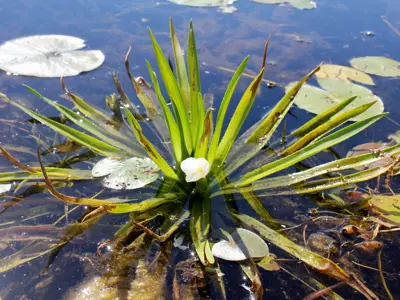Water soldier can be easily distinguished from other aquatic plants by its leaf that has sharp spines along the edges.
Water Soldier

Water soldier (Stratiotes aloides) is an alien, invasive perennial aquatic plant that is native to Europe and Northwest Asia. It was first found in North America, in the Trent River in 2008. It has spread downstream and was recently detected in several locations in the Bay of Quinte. Water soldier is now a prohibited invasive species in Ontario.
Prior to its regulation in 2016, under Ontario’s Invasive Species Act, water soldier was sold commercially as a plant for use in ornamental water gardens and that is the likely source of the plants now found growing in the wild in Ontario.
Water Soldier reproduces very quickly. It reproduces through its offsets, turions and clonal fragmentation for dispersal. The offsets act similar to those produced by the household spider plant and they look like smaller versions of the adult plant.
Water soldier is capable of reproducing without seeds through a process known as vegetative reproduction. New buds, that look like small versions of the mature plant, develop and detach to over-winter. The “parent plant” sinks to the bottom of the water body by November and overwinters.
Its abundant growth can alter wetland ecosystems by converting open water habitats into dense stands of vegetation, which can negatively affect the fish and wildlife that use these habitats.
Dense floating mats of Water soldier can interfere with recreational activities, such as boating, angling, and swimming. Caution should be exercised whenever handling the plant because of the sharp edges of the leaves.

Technical Working Groups
Since 2023, two technical working groups, Trent-Severn Waterway and Bay of Quinte, have been working together to manage Water Soldier.
Since the initial discovery of Water Soldier in the Trent River, an inter-agency Technical Working Group was created to help coordinate research, monitoring, control, and prevention strategies. Quinte Conservation joined the Technical Working Group once the plant entered the Bay of Quinte.
- Canadian Wildlife Services
- Department of Fisheries and Oceans
- Lower Trent Conservation
- Ministry of the Environment Conservation, and Parks
- Ministry of Natural Resources
- Mohawks of the Bay of Quinte
- Ontario Federation of Anglers and Hunters
- Parks Canada
- Royal Canadian Airforce (8 Wing Trenton)
- Trent University
Bay of Quinte
Water solider was discovered in the Bay of Quinte in 2021.The detection of water soldier in the Bay of Quinte was important because it is one of the only locations in Ontario where water soldier is known to be present in the wild.
The Bay of Quinte provides water soldier with ideal habitat conditions to thrive such as mesotrophic to eutrophic conditions in standing to slow flowing waterbodies at depths of up to five metres. Water soldier poses a significant threat to the Bay of Quinte ecosystems that Bay of Quinte Remedial Action Plan and other organizations have worked hard to restore and remediate.
The proposed approach to address water soldier has been developed, based on the guidance provided by the members of the Bay of Quinte – Water Soldier Working Group, and is also informed by the Prevention and Response Plan for Water Soldier in Ontario. The strategy focuses on three key elements:
- Environmental DNA surveillance of Bay of Quinte and Lake Ontario, with water samples collected by several partners agencies to be analyzed for the presence of Water soldier DNA by the Ministry’s genetics laboratory. This is to help direct monitoring efforts in the Bay of Quinte.
- Quinte Conservation performs aquatic vegetation surveys in 15 coastal wetlands in the Bay of Quinte which is already part of QC's routine monitoring program.
- Monitoring and mapping of known populations of Water soldier to inform control activities. This is through vegetation surveys. Based on the eDNA, external reports from the public and the results from the 2022 surveillance, water solider vegetation surveys are ongoing to determine population size and guide management decisions. The protocol utilizes a 50 x 50 metres grid to survey areas and the data at the points collected includes water depth, water soldier ranking value which indicates presence of Water Soldier, and the top three abundant aquatic plant species.
Diver Assisted Suction Harvesting
Diver assisted suction harvesting is not readily available and it would not be ideal for the Bay of Quinte due to silty and muddy substrates.
Herbicide Application
Herbicide applications have proved the most successful management control option in the Trent River. It is typically applied in the fall once the native vegetation has receded to prevent harm to native species of plants.
Manual Removal
Manual removal of water soldier involves using hand-held devices (e.g., rake) to tackle individual plants and small groups of plants (generally between May and August). This has been ongoing for smaller populations.
Mechanical Harvester
Mechanical harvesting was proposed for 2023, however, access to a functioning harvester was not possible for the timeframe it was required. Mechanical Harvesting is better performed in the spring before the turions are produced by the water soldier to prevent spreading. It is effective to control mid-size populations in accessible locations with a near-by accessible boat launch, and areas to offload and dispose of large volumes of plant material.
Shade Cloth Enclosure
The shade cloth enclosure is not ideal for the Bay of Quinte due to wave action and boat traffic.

